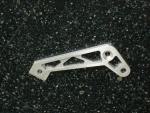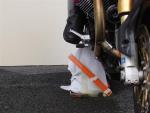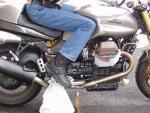
Ryland3210
Members-
Posts
1,033 -
Joined
-
Last visited
-
Days Won
1
Content Type
Profiles
Forums
Events
Gallery
Community Map
Everything posted by Ryland3210
-
Thanks! I'm going out of town tomorrow morning, and won't be able to take pictures of the left side until late next week. I'll get to it as soon as I can. Basically, the peg position is moved exactly the same way on both sides. The brake and shift lever positions are both adjustable, like the original. I also am making another version of the shift rod actuating stamping to see how a longer stroke feels. I'll work up what it would cost to make up some sets of parts. A lot depends on how many I am asked to make up. I'll absorb the CNC programing and R&D costs, but there is still the pattern and tooling cost for the shift lever. Designing the shift lever was quite difficult and required a little trial and error. I made mine the laborious way with no pattern or tooling costs, but for any quantity, investment casting followed by heat treating and finishing would make more sense. I'll keep checking this thread to see how much interest there is, and meanwhile figure out the costs versus quantity.
-
They might, if I had any cornering abilities to begin with. In my case, outriggers would be a plus. The rag was an expedient to prevent the bright orange jack stand from causing a confusing background for the pictures.
-
Have you tried it with zero fairing? I took my Sport's off because the wind blast off the original fairing was right at my face at a higher density than the ambient. I noticed when standing up, there was considerably less wind in the face. Without the fairing, less wind in the face, and only a little more in the chest area. Of course, lying down on the tank at motorway speeds would result in better shelter with the fairing, but personally, I'm happier this way, whether it's raining or not.
-
Super! They're in the mail. Thanks
-
Looking for the best of two worlds, I designed and built a set of peg brackets, brake and shift levers to move my foot position forward and slightly down. I love the Cafe Sport's modernity and performance, but my knees have been abused by decades of dirt riding, backpacking and squash, and they object to long periods bent as far as the original controls require. I missed my Norton Commando with its relaxed peg position. The challenge was to retain as much cornering clearance as possible and the same leverage ratios so the stroke and pressure required for shifting and braking would be the same as Guzzi's engineers'. The pegs were moved forward a substantial 5.5 inches, and only slightly downwards, to the same level as the Centauro. For primarily cosmetic reasons and in keeping with the "naked" style of the bike, a considerable amount of aluminum was machined out to lighten everything. I'm very happy with the results. I have some pictures of the results. Two show the original and forward foot positions relative to a 45 degree triangle. They show there is very little difference in ground clearance because as the foot is positioned forward, the toe naturally angles more horizontally instead of downwards. Of course those with more flexible legs than me can move their toes up to the pegs. In my case, I'm content to pull 1 G plus corners without having to do that and with my feet in the forward position. From left to right, top row: Forward Foot Position, Forward Leg Position, Left Peg Bracket, Original Foot Position Bottome row: Original Leg Position, Shift Lever. Missing is the Right Peg Bracket and Brake Lever Assembly Picture. I'll send that to Admin Jaap shortly.
-
Yuasa makes a model with the correct polarity and dimensions for horizontal application. The factory prepared version from Bombardier is the only version they recommend for motocycles. I received a new one just last summer. It works fine, but seems to have a self discharge rate higher than what I would expect. See the thread on "do horizontal batteries always leak" for an overabundance of details. Odyssey makes a metal jacketed version as well. If I were to buy one and was concerned about the weight of the seat on the battery case (no problem in my case), I would go for the MJ version.
-
You're absolutely welcome. I'm glad I found the old version in my archives, and the new one was still available. I think this source is clear and credible enough to put in FAQ's. If you know how to do that, it's my suggestion. If anyone needs it in Lotus 123 format, I can reply with a WK1 file. Not so elegant, but the same data.
-
Norton cases?! I'm impressed! Nothing worked 100% on mine, though I think oil weeped through porous die castings, since I worked so hard on the joints. What's Yamabond made of? Is it a silicon caulk or something else?
-
There is a pretty thorough website that shows charts and tables, along with a load of instructive stuff including how to remedy sulfated batteries. They had published an earlier version which I found ambiguous regarding which way to make the corrections of voltage for temperature. They have replaced the formula and correction example, which could be interpreted in both directions with a downloadable table. It supplies a float maintenance voltages versus temperature chart as well. Try this: www.uuhome.de/william.darden
-
My comments were relevant to the SOC and Charging voltages. In both those cases, the voltages are inversely related to temperature. I believe we agree on this. I don't think there is any conflict here. However, that's different from the variation of open circuit (neither charging nor discharging) battery voltage with temperature, which Gary indicates is a positive relationship. No conflict here either, because I haven't commented on that, haven't done any research or experimenting on it, so I have no reason to doubt Gary.
-
My numbers came from none other than the Battery University website! I had a recollection that there was a negative voltage temperature coefficient from looking into this years ago, so I looked it up. I designed an electronic voltage regulator to replace the relay devices used back in the 60's. It worked pretty well. My '63 Olds' original battery outlasted the car, which died around 1972. It still ran great, with about 180,000 miles, but after bringing it back to Aamco for the fourth time for a replacement transmission (they gave a real lifetime guarantee back then), Aamco refused to honor it any longer, so I gave the car to the mechanic in the shop. I have no idea how much longer the battery lasted, but it was still starting the ungaraged Olds right through the winter with no problem I think Gary and I are in what I call "violent agreement"! He's provided a thorough description of the interactions as I understand them.
-
My understanding is as follows: They do mean no limit to current if you obey the charging voltage limit. The current will not go to thousands of amps, which would destroy the battery, if the voltage is limited. The SOC voltage varies relative to temperature at - 3mv/degrees C. There is an interference problem on some models. That's why I had to modify the battery bracket and carve a piece out of my seat, as I described previously. Your battery is doing a hell of a lot better than mine. My battery, less than one year old, loses 25% of its charge in a week! It is the rate of self discharge, not the leakage in the bike. Not acceptable in my book, and this will all the precautions I took to prevent the seat from resting on the battery, getting a new factory prepared version, and doing a very careful initial charge. What model battery are you using? Is it mounted under the seat horizontally? How old is it? Does the seat bear down on it? I'd be very grateful for the info. To clarify, that's -3mv/degree C PER CELL, or -18mv for a 12 volt battery
-
Yes, but note that my reference is speaking of the voltage to which a battery should be charged to obtain a given percentage of charge as a function of temperature. i.e. a cold battery must be charged to a higher voltage to reach 100% of capacity. And as you say, its capacity will be higher at higher temperatures.
-
A clarificaton: 20 degrees C is not an "optimum" temperature, just used as the benchmark for most physical specifications because it is a typical room temperature. A 40 degrees F difference would correspond to 0.4 volts. BTW, I agree with Gary on avoiding deep discharge of lead acid batteries. One of the differences between deep cycle batteries is a larger distance from the bottom of the plates to the bottom of the case. This is to allow more space for material sloughed off the plates caused by deep discharging/charging cycles-not something you want to do on purpose.
-
This certainly has my attention! Intermittent connectors are a pet peave of mine. Where do I look to prevent this potential nightmare out on the road? 2004 Cafe Sport is my steed. Thanks, John
-
According to the "Battery University", for charging lead acid batteries: "General guidelines suggest a compensation of approximately 3mV per cell per degree Celsius. The voltage adjustment has a negative coefficient, meaning that the voltage threshold drops as the temperature increases." For example, with a 12 volt lead acid battery having 6 cells, if the battery's temperature is 5 degrees C above the 20 degree C standard measurement temperature, ( 77 F instead of 68 F), the equivalent voltage would be - 3mv X 6 cells X 5 degrees C = - 90mv (lower) or said another way: 1/10 volt lower for each 10 degrees F higher than 68 degrees
-
-
Add me to the list for a full set. How far from Warwick, NY is Watertown?
-
FWIW, I attached a chain hoist to a rafter and use slings to lift the bike up as high as I like, with nothing underneath in the way. I can either sit on a chair or stand up, as I wish. There are also reasonably priced electric hoists from Harbor Freight.
-
Enlighten me, please. With the Ohlin's already there, what's to be done in terms of set up? The Cafe Sport has the crossover under the belly, so how much difference would locating them closer to the exhaust ports make? Is it anything nearly as critical as 2 stroke exhaust tuning is?
-
Is the fitting on your tank a simple barb type? You may want to consider using a clamp on the fuel vent so it doesn't slip off when putting the tank back on and tying the vent valve vertical.
-
Perhaps the dealer put it on my 2004. I wasn't imagining things. There was only one, on the tank overflow. It's still there.
-
On my 2004 Cafe Sport, the fuel vent line was clamped on with a crimp clamp. I finally gave up trying to clip the clamp off,. I cut the hose down below the intake horns and above the throttle body where I could put it back together with a pair of hose clamps and a brass connector, and it wouldn't show once the tank was back on. I had taken the tank off to tie the vent valve in the vertical position to prevent the "tank suck". If you haven't done this yet, it's a good idea while you have the tank off.
-
Upshifting has been a little more difficult than I expected. I just noticed that the tie rod to the transmission shift crank interferes with one of the two hoses that are tie wrapped such that they are right behind the tie rod end. When upshifting, it would contact the hose. This explains why I learned to yank up pretty hard with my toe to upshift. I had to overcome the resistance of the rubber hose and compress it. One solution might be to adjust the tie rod, but that would lower the shift lever position. Instead, I clipped off the OEM tie wrap, repositioned the two hoses and tie wrapped them out of the way.
-
I haven't done any research on whether the modern multi's and synthetics break down to the lower viscosity range, as they used in the bad old days at high temperatures. I used to stick to straight 50 with my Norton. It would get pretty hot, air cooled, no oil cooler either. I'm thinking of using diesel grade Shell Rotella straight 40. I'm not worried about cold starting. Anyone out there with some objective information? I'd really appreciate it.






